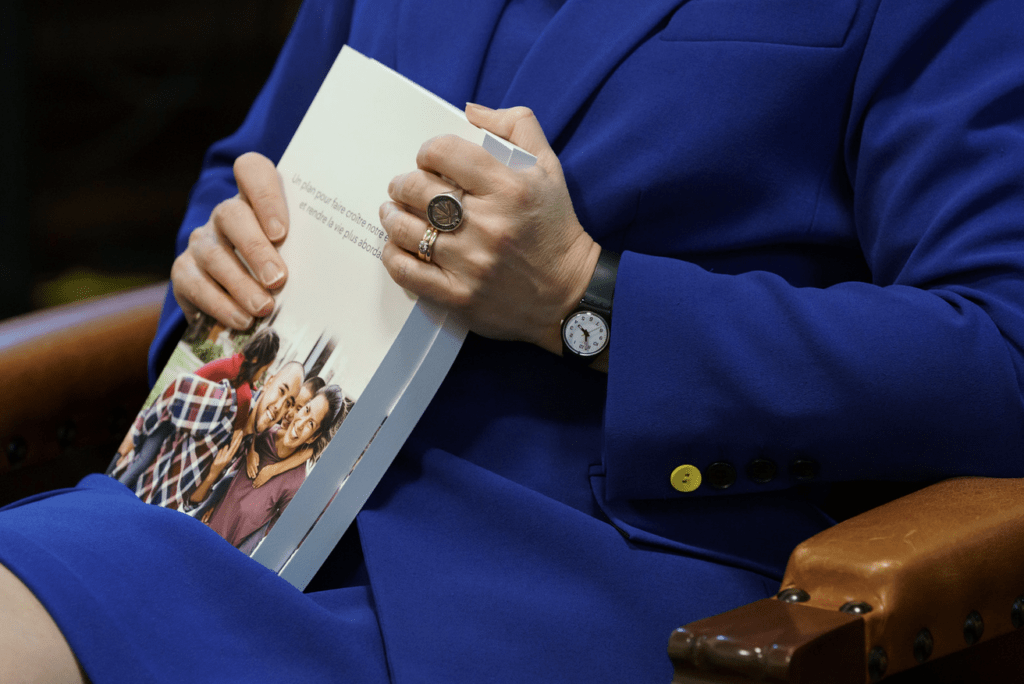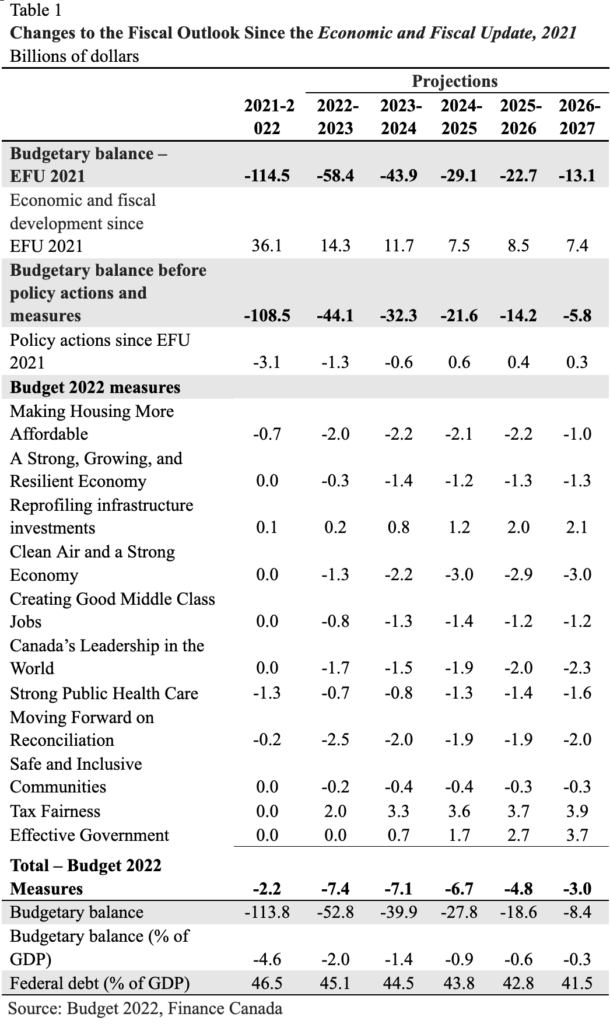Budget 2022: Modest, Measured, and Responsible in Uncertain Times

Kevin Page with Sahib Dhaliwal and Meagan Frendo
April 8, 2022
Deputy Prime Minister and Finance Minister Chrystia Freeland tabled Budget 2022 in Parliament on April 7, 2022. It was titled “A Plan to Grow Our Economy and Make Life More Affordable”. Growth and affordability are the right policy priorities in an economic environment facing a second global supply shock in a few years and high and rising price inflation.
Will the budget deliver on these priorities? Over the short term, growth and price inflation will largely be influenced by global responses to Russia’s invasion of Ukraine. Over the medium and long-term, efforts by the government (working with other governments, households and the private sector) to boost productivity, labour force growth, inclusion and sustainability can make a measurable difference to the quality of life of Canadians.
Budget 2022 is surprisingly measured, modest and responsible.
Many budget observers had early expectations and concerns about a big- spending budget financed largely through higher deficits. These expectations were fueled by the recent Liberal-NDP agreement on priorities and policies, as well as pressures to increase defence spending towards NATO targets. In the current environment, more deficit spending focused on boosting consumption (demand) versus investment (supply) would add to inflation.
Business leaders raised concerns that the Liberal Party did not give enough focus to a growth agenda in its 2021 election platform. The economy needs to grow to raise revenues to pay for improved social supports.
To give credit where credit is due, the Liberal government put together a fiscal strategy that largely addresses these concerns. Planned budgetary deficits and the debt-to-GDP ratio are reduced relative to the Fall 2021 Economic and Fiscal Update. New spending is limited. Efforts to address growth and affordability are more focused on the medium-term, with policies aimed at increasing supply (e.g. housing stock) and longer term growth (e.g., innovation, green economy).
Households and businesses looking for significant new short-term relief on recent and expected rising cost pressures will largely be disappointed. Fiscal responsibility is not politically easy.
The fiscal contours of Budget 2022 are measured and in proportion. From above, they look deliberately shaped as a tailor would cut cloth for a suit or dress.

A stronger economic outlook relative to the Fall 2022 Update generates $85 billion in additional fiscal room over the medium term (Table 1). About one third of this additional room ($31 billion) is allocated in net new spending. The remainder is allocated to improving the deficit track.
Gross new spending totals about $62 billion in the medium term over a number of spending areas (housing, growth, sustainability, labour force, security, health, reconciliation, inclusion and taxation). About half of this gross spending is offset fiscally by new taxation, planned efficiency savings and re-profiled infrastructure spending. Net new spending is relatively balanced across spending areas and across the medium term (i.e., not front-end loaded).
The new spending measures are modest.
Net new spending in Budget 2022 is about half the amount highlighted in the Liberal 2021 election platform. A total of $31 billion over six years must be compared with total program federal spending in 2022-23 of $425 billion in a $2.7 trillion economy. Total net spending in Budget 2022 is roughly equivalent to one signature initiative in Budget 2021 (Canada-wide Early Learning and Child Care System).
The government can claim that this fiscal plan is responsible.
Budgetary deficits fall significantly — from $114 billion in 2022-23 (4.6 percent of GDP) to $53 billion in 2023-24 (2.0 percent of GDP) to $8 billion in 2026-27 (0.3 percent of GDP). The government’s fiscal anchor – a declining debt to GDP ratio – falls from 45 percent in 2022-23 to 42 percent in 2026-27. The carrying cost of debt remains low by historical standards. Canada’s debt to GDP ratio remains low relative to other major economies.
There is a large drop in the estimated budgetary deficit in 2021-22 from $145 billion to $114 billion. About two thirds of this decline comes from higher-than-expected revenues. The downward adjustment will raise confidence that the government can best it’s fiscal estimates in uncertain times.
Measured, modest and responsible does not mean the government has a comprehensive plan for growth and affordability or one that addresses all commitments highlighted in the election, the Liberal-NDP agreement, or to NATO. At best, it can be said that deliberative fiscal and policy measures have been made on many fronts, with potentially large unfunded policy commitments that remain to be addressed (e.g., Pharmacare, NATO). The latter would require significant taxation increases for the government to remain fiscally sustainable. Fiscal responsibility requires tough choices with budgetary constraints. Fiscal responsibility must be calibrated for the times.

Measured, modest and responsible does not mean the government has a confident economic planning outlook. There is enormous economic uncertainty in 2022. Russia’s invasion of Ukraine and associated sanctions could have significant stagflationary consequences (i.e., lower output, higher unemployment, higher inflation, higher interest rates). These consequences are not reflected in the average private sector forecast, which is based on a pre-war (February) survey (Table 2). As global events have unfolded in recent weeks, it is reasonable to assume that the strength of the planning outlook will deteriorate.
The government’s policy response to this uncertainty was to table a modest and measured budget that would not push up the inflation rate in the short term and leave some fiscal space to absorb deteriorating economic conditions. It did not build in contingency reserves in its planning framework as previous Liberal Finance ministers have done in the past. Measured and modest does not necessarily mean prudent with respect to large potential negative economic risks.
It is expected that Budget 2022 will survive a vote of confidence in Parliament with the help of the NDP. This will be followed by tax and spending legislation over the course of the year.
In the current uncertain global environment, it is probable that we will see a significant fiscal update in the fall with a different economic outlook and a rethink of fiscal strategy. Modest and measured does increase policy flexibility. Stay tuned.
Kevin Page is the President of the Institute of Fiscal Studies and Democracy at the University of Ottawa, former Parliamentary Budget Officer and a contributing writer for Policy Magazine.
Sahib Dhaliwal and Meagan Frendo are undergraduate economics students at the University of Ottawa.
